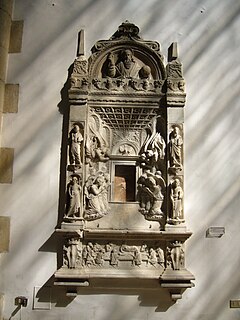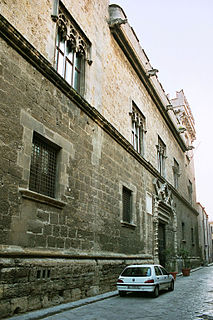Related Research Articles

Antonello da Messina, properly Antonello di Giovanni di Antonio, but also called Antonello degli Antoni and Anglicized as Anthony of Messina, was a Sicilian painter from Messina, active during the Early Italian Renaissance. His work shows strong influences from Early Netherlandish painting, although there is no documentary evidence that he ever travelled beyond Italy. Giorgio Vasari credited him with the introduction of oil painting into Italy. Unusually for a south Italian artist of the Renaissance, his work proved influential on painters in northern Italy, especially in Venice.

Petrus Christus was an Early Netherlandish painter active in Bruges from 1444, where, along with Hans Memling, he became the leading painter after the death of Jan van Eyck. He was influenced by van Eyck and Rogier van der Weyden and is noted for his innovations with linear perspective and a meticulous technique which seems derived from miniatures and manuscript illumination. Today, some 30 works are confidently attributed to him. The best known include the Portrait of a Carthusian (1446) and Portrait of a Young Girl ; both are highly innovative in the presentation of the figure against detailed, rather than flat, backgrounds.

Antonello Gagini (1478–1536) was an Italian sculptor of the Renaissance, mainly active in Sicily and Calabria.

Domenico Gagini was a Swiss-Italian sculptor who was active in Northern as well as Southern Italy.

Renato Guttuso was an Italian painter and politician. His best-known works include Flight from Etna (1938–39), Crucifixion (1941) and La Vucciria (1974). Guttuso also designed for the theatre and did illustrations for books. Those for Elizabeth David’s Italian Food (1954), introduced him to many in the English-speaking world. A fierce anti-Fascist, "he developed out of Expressionism and the harsh light of his native land to paint landscapes and social commentary."

Guglielmo Borremans or Guglielmo Fiamingo (1670–1744) was a Flemish painter whose documented career took principally place in Italy, in particular Naples, Cosenza and Sicily. Here he was one of the pre-eminent late-Baroque fresco painters of the first half of the 17th century who received multiple commissions to decorate churches and palaces.

Italian Renaissance painting is the painting of the period beginning in the late 13th century and flourishing from the early 15th to late 16th centuries, occurring in the Italian peninsula, which was at that time divided into many political states, some independent but others controlled by external powers. The painters of Renaissance Italy, although often attached to particular courts and with loyalties to particular towns, nonetheless wandered the length and breadth of Italy, often occupying a diplomatic status and disseminating artistic and philosophical ideas.

Lieven Mehus or Livio Mehus was a Flemish painter, draughtsman and engraver of the Baroque period, who trained and worked in Italy. He was mainly active in Florence where he was court painter of Prince Mattias de' Medici. During his lifetime he enjoyed a high reputation for his allegorical and mythological scenes, landscapes, religious works and portraits.
Antonello da Caserta, also Anthonello de Casetta, Antonellus Marot, was an Italian composer of the medieval era, active in the late 14th and early 15th centuries.

Palazzo Abatellis is a palace in Palermo, Sicily, southern Italy, located in the Kalsa quarter. It is home to the Galleria Regionale della Sicilia, the Gallery of Art for the Sicilian region.
Antonello Crescenzio, known as Antonello da Palermo, who, according to De Marzo, was the son of Antonio Crescenzio, was born early in the 16th century, and practised both as a sculptor and a painter. He was an assistant to the sculptor Gagnino in 1527. In 1537 he completed two copies of Raphael's 'Spasimo;' one of them is in the Carmelite Church at Palermo, and the other in the Monastery of Fazello, near Sciacca. The date of his death is uncertain.

San Gregorio Polyptych is a polyptych painting by the Italian Renaissance master Antonello da Messina, completed in 1473 and housed in the Regional Museum of Messina, southern Italy.
Riccardo Quartararo was an Italian painter of the Renaissance period, active in Sicily and Naples.
The Gagini or Gaggini were a family of architects and sculptors, originally from Bissone on Lake Lugano. This family founded Sicily's Gagini school, which flourished until the mid-1600s.

The Church of Saint Francis of Assisi is an important church of Palermo. It is located near the main street of the city, the ancient Cassaro, in the quarter of the Kalsa, within the historic centre of Palermo. The building represents the main Conventual Franciscan church of Sicily. It has the title of Minor basilica.

Crescenzio Onofri or Crescenzio d'Onofri was an Italian landscape painter, draughtsman and engraver who worked in Rome and Florence. A presumed pupil of Gaspard Dughet he collaborated with many specialist figure painters of his time.
Antonello is an Italian masculine given name as well as a nickname and surname that is a variant of Antonio. Notable people with this name include the following:
The Diocesan Museum of Palermo is a museum of religious art in Palermo on Sicily, housed in a number of rooms in the Palazzo Arcivescovile opposite Palermo Cathedral.
Vincenzo La Barbera was an Italian Mannerist architect and painter.

The Sicilian Renaissance forms part of the wider currents of scholarly and artistic development known as the Renaissance in Italy and Europe as a whole. Spreading from that movement's main centres in Florence, Rome and Naples, when Renaissance Classicism reached the island of Sicily it fused with influences from local late medieval and International Gothic art and Flemish painting to form a distinctive hybrid. The 1460s is usually identified as the start of the development of this distinctive hybrid Renaissance on the island, marked by the presence of Antonello da Messina, Francesco Laurana and Domenico Gagini, all three of whom influenced each other, sometimes basing their studios in the same city at the same time.
References
- ↑ Delle belle arti in Sicilia, Volume 3, by Gioacchino Di Marzo, (1862) page 110-114.
| | This article about an Italian painter born in the 15th century is a stub. You can help Wikipedia by expanding it. |
| | This article about an Italian sculptor is a stub. You can help Wikipedia by expanding it. |